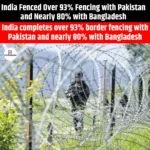CP Radhakrishnan named NDA’s Vice Presidential Candidate
|
General Studies Paper II: Parliament, Constitutional Bodies, Executive |
Why in News?
The National Democratic Alliance has recently declared CP Radhakrishnan as its nominee for the Vice Presidential election. The Vice President election is scheduled for September 9 this year.
Who is CP Radhakrishnan?
-
- CP (Chandrapuram Ponnusamy) Radhakrishnan is a senior Indian politician known for his long journey in public life. He has held several significant positions in Parliament and in state-level politics.
- Early Life: Chandrapuram Ponnusamy Radhakrishnan was born on 20 October 1957 in Tiruppur, located in the then Madras State, which is now Tamil Nadu.
- He was born to C. K. Ponnusamy and K. Janaki, who shaped his early life in Tamil Nadu.
- As a young boy, he showed interest in sports and was particularly active in table tennis during his college days.
- He studied at V. O. Chidambaram College in Thoothukudi, where he earned a Bachelor of Business Administration (BBA) degree.
- His early years also brought him closer to the Rashtriya Swayamsevak Sangh (RSS), where he developed a sense of discipline and commitment to public life.
- At just 17, he became actively associated with the Bharatiya Jana Sangh, which later merged into the BJP. This early start laid the foundation for his lifelong association with political and social movements.
- Personal Life: Radhakrishnan married R. Sumathi on 25 November 1985. They have two children.
- He is associated with community service initiatives and has been a member of Lions Clubs International.
- He enjoys physical activities like cricket, volleyball, and running, which reflect his interest in sports and fitness even in his later years.
- Political Career: Radhakrishnan’s entry into national politics became prominent in the late 1990s.
- In 1998, he secured victory from the Coimbatore constituency in the Lok Sabha elections as a BJP representative. He repeated his success in 1999, defeating R. Nallakannu of the Communist Party of India.
-
-
- In Parliament, he served on key committees, including the Parliamentary Committee on Public Sector Undertakings and the Consultative Committee for Finance.
- In 2003, he represented India at the 58th United Nations General Assembly, where he spoke about humanitarian aid and disaster relief coordination.
- He was appointed the President of BJP’s Tamil Nadu unit in 2004-2007. He led a state-wide yatra covering all constituencies, focusing on different issues.
- Between 2016 and 2020, he headed the Coir Board of India, a body under the Ministry of Micro, Small and Medium Enterprises.
-
- Governorship: In February 2023, Radhakrishnan was appointed as the Governor of Jharkhand, where he worked with different state governments, including the leadership of Hemant Soren and Champai Soren.
-
- In March 2024, he was entrusted with additional responsibilities as the Governor of Telangana and the Lieutenant Governor of Puducherry.
- On 31 July 2024, he officially became the Governor of Maharashtra, taking over from Ramesh Bais.
Vice Presidential Election Schedule 2025
- Notification: The Election Commission of India issued the official notification for the Vice Presidential election on 7 August 2025.
- Nomination: The last date to file nominations was set for 21 August 2025. During this period, candidates backed by Members of Parliament could officially submit their papers. Each nomination required support from at least 20 proposers and 20 seconders from the electoral college, which is made up of members of both Houses of Parliament.
- Scrutiny: The scrutiny of the submitted nominations was scheduled for 22 August 2025. On this day, officials examined whether the papers filed by candidates complied with the rules and constitutional requirements. Candidates who fail to meet the eligibility criteria are disqualified during this stage.
- Withdrawal: The final date for the withdrawal of candidature was 25 August 2025. This stage provided candidates the option to withdraw voluntarily if they lacked sufficient support or if political parties altered their strategies. The final list of contesting candidates was confirmed and made public.
- Polling Day: If necessary, the election would proceed to polling on 9 September 2025. The voting is conducted inside Parliament House in New Delhi.
- Counting of Votes: The counting of votes is also scheduled for 9 September 2025, the same day as polling. Once the ballots are tallied, the Returning Officer announces the winner.
How the Vice Presidential Election is Conducted?
-
- Constitutional Provisions: The Vice Presidential election in India is conducted under the framework of the Constitution and the Presidential and Vice-Presidential Elections Act of 1952. The process is designed to ensure fairness, transparency, and strict adherence to parliamentary democracy.
- The Constitution of India, under Articles 63 to 71, lays down the rules regarding the office of the Vice President.
- Article 67 states that the Vice President holds office for a term of five years from the date of assuming charge.
- Article 68 clarifies that if the office falls vacant due to resignation, removal, or death, the election to fill the vacancy must be conducted as soon as possible.
- Constitutional Provisions: The Vice Presidential election in India is conducted under the framework of the Constitution and the Presidential and Vice-Presidential Elections Act of 1952. The process is designed to ensure fairness, transparency, and strict adherence to parliamentary democracy.
- Election Commission: The Election Commission of India plays the central role in conducting the Vice Presidential election. It issues the notification, sets the calendar, and ensures that every step follows the law. The Commission also appoints a Returning Officer, usually the Secretary-General of either the Lok Sabha or Rajya Sabha, to oversee the nomination, polling, and counting process.
- Electoral College: The electoral college for this election consists of members from both the Lok Sabha and the Rajya Sabha, including nominated representatives.
- Unlike the Presidential election, where members of state legislatures also take part, this election is restricted only to Parliament.
- In 2025, the electoral college consisted of 781 members: 542 from the Lok Sabha and 239 from the Rajya Sabha.
- Nominated members of the Rajya Sabha also enjoy voting rights in this election. Each MP has one vote of equal value.
- Voting Method: The election is conducted through a secret ballot system, ensuring confidentiality of votes.
-
-
- Voting is carried out through proportional representation, using a single transferable vote system to ensure fairness.
-
- In practice, since each MP casts only one vote, the candidate securing more than half of the valid votes polled is declared elected. The ballot paper is marked with preferences, giving MPs the freedom to rank candidates.
- Result: The polling takes place inside Parliament House in a designated room. Once polling concludes, ballot boxes are sealed in the presence of candidates’ representatives. Counting of votes is usually completed on the same day. The Returning Officer supervises the counting, and results are declared immediately after tallying. The name of the elected candidate is then officially communicated to the President of India, who administers the oath of office.
|
National Democratic Alliance (NDA)
|
|
Articles related to Vice President of India |
|









